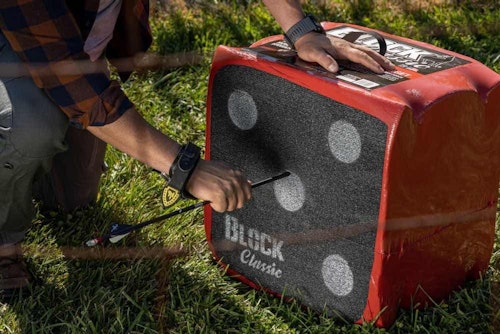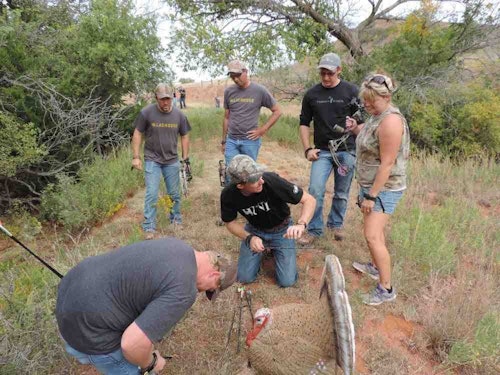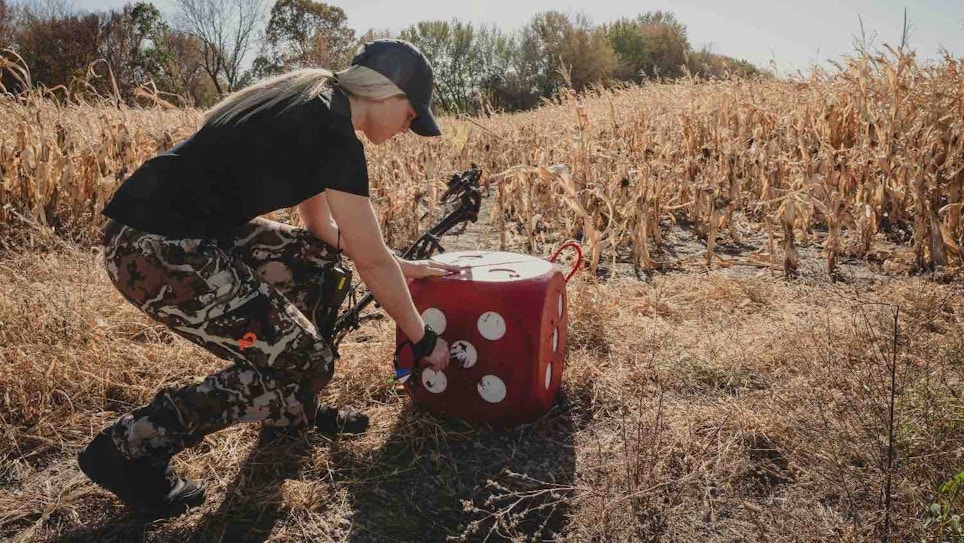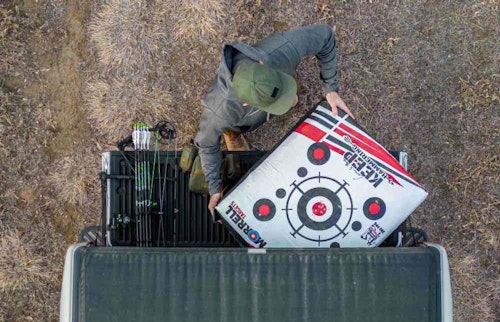If you’re a salesman in any industry, selling products that wear out and require replacing is a sure way to stay busy. Now, I’m not talking about cheap junk that falls apart and is undependable. I’m talking about products that, with regular use, have life expectancies. Think about tires, shoes or blue jeans.
There are several such products in archery. For example, bowstrings and cables fray. Arrows and their components break or are lost. Broadhead blades dull. And targets reach a point when they no longer effectively stop arrows.
While targets are a great product category for an archery retailer to deal in, selling a pile of them each year isn’t exactly as simple as loading your shelves and waiting for an onslaught of customers to come buy them. If you want to have your piece of the target-sales pie, then heed the input of several dealers I talked with recently.

Identify Hot Types and Price Ranges
Just like bows or arrows, targets come in many different types and grades. Bag targets range from around $30 to well beyond $100. 3-D targets begin around $80 for a Delta McKenzie woodchuck to more than $2,000 for a Rinehart or Delta McKenzie bison target. Lastly, decent foam broadhead targets begin around $50 and range up to $150 or even more. Given these stats, which target styles and prices will sell like hot cakes?
For Josiah Richards of Ross Outdoors in Phoenix, Arizona, it looks like this: “Most of our target buyers are bowhunters, yet we find 3-D targets more challenging to sell,” he said. “Bag targets make up the largest volume of our target sales. We sell a lot of bag targets in the $50-$60 range. For 3-Ds, customers rarely spend more than $150. Hog, deer and turkey 3-D targets are most popular because they’re more portable and affordable than elk targets.”
John Vernetti of Royal Gorge Archery and Range in Canon City, Colorado, also reported strong bag-target sales and a smaller percentage of the other types.
“We undoubtedly sell more bag targets than anything else,” he said. “In the 3-D category, elk targets are too expensive for our demographics, so we sell a lot more deer targets, mostly in the $150 price range. We sell some broadhead targets for around $150.”
Nicole Tindale of Flaming Arrow Archery in Kalispell, Montana, reports doing well across the different target styles.
“We typically sell a good mix, though bag targets are just so much more affordable,” she started. “Before suggesting a target to a customer, we ask them some questions. We want to know if they are just starting out and shooting only field points, or if they’re also shooting broadheads. That helps our staff suggest something that meets their needs. Bags are much more affordable than 3-D targets, and we don’t want our customers spending more money than they have to if they’re shooting only field points.”
Focus on Key Brands and Models
As with most categories, ordering too many brands and SKUs can be detrimental. So, simplify your strategy and don’t become bogged down with too many targets. Focus on two or three key brands.
“We sell Block and Rinehart,” Richards said. “We do very well with Rinehart’s bag targets. For broadhead targets, folks usually go with the Block Vault XL or the Block 6x6. Rinehart’s Woodland Series has outsold all other 3-D targets. They’re priced right, yet long-lasting.”
Vernetti sells more Morrell bag targets than any other, and like Richards, offers and sells Rinehart bags, too. But, he’s also found some success with certain 3-Ds.
“For 3-D targets, we carry a few from Delta McKenzie, but most folks buy Rinehart,” Vernetti shared. “We mostly deal with the Rinehart Woodland Series for our bowhunting customers, but we also sell the more expensive Rinehart 3-Ds to folks who shoot competitively. Those run about $300 MSRP on average.”
I also spoke with Brent Smith of Slingin’ Arrows in El Dorado, Arkansas. He said, “We sell targets from Morrell, Block and Hurricane. Morrell bag targets easily outsell the rest,” he said. “The Yellow Jacket Supreme 3 is by far the most popular bag for us. Portability and affordability are the two main reasons bag targets are our top sellers.
“If someone knows what type of target they want, I’ll explain the differences between the models I offer, and help them settle on one that works for them. I don’t push one particular target. I find out what the customer is looking for and then go from there.
“Block is our most popular broadhead target. Block does well with advertising, and they’re good-quality targets, too. People want a broadhead target that lasts, and these seem to hold up quite well. Folks get a good target for their money.”
Finally, Evan Careenas of Riverside Archery in Riverside, California, said, “Morrell targets are the most popular for the value. The Yellow Jacket and Super Duper sell really well, and we also do well with the Outdoor Range. Rinehart’s Badger Bag is also a nice affordable target that’s easy to sell, especially when a customer is buying a new bow. The price and convenience of the entry-level bag targets make them no-brainers.”
Offer Something for Everyone
If you’re a smaller retailer, again, focusing on two or three brands is better than offering six. However, within those key brands, try to offer a mix of different targets. In other words, offer something for everyone, but within reason. In a perfect world, have bags, 3-D targets and broadhead targets, but don’t bring in six 3-D elk targets that retail for more than $2,000 apiece. Decide wisely on a decent mix of bags, broadhead targets and 3-Ds, spending most conservatively on high-end 3-Ds because they tend to move slower for most stores.
When you’re shopping for targets, especially at the ATA Trade Show or buying-group shows, watch for volume pricing with programmed delivery dates. These tend to be most common with bag and broadhead targets. Taking advantage of good buys is a great way to offer more targets at better pricing.

Display Tips
Every store lays out differently, so try to work with what you have. If you’re limited with space, display fewer targets and keep the rest of your stock in the back. Go for visibility, but don’t create jams that cut into traffic flow.
“We display our targets in various locations throughout the store,” Richards said. “We have a lot of storage space in the back, which allows us to stay stocked up. Our shop has a shooting range, but we haven’t held a 3-D shoot yet in our new location. When we do, I imagine it will help us sell a few more 3-D targets than we currently do.”
Vernetti said it’s all about visibility at Royal Gorge Archery and Range. “We display our targets on a rack located near our indoor range,” he said. “It’s where our customers set their bow cases when they come in to shoot. It’s a good, high-visibility location. We have very little storage space, so we typically reorder several times throughout the year to keep stocked up. I’ll bring in a dozen Morrells at a time and maybe three to four Blocks and some Rineharts. That’s what our display holds.”
Careenas said that Riverside Archery displays targets in multiple locations. “We have a rather large layout of targets in our store,” he explained. “We put them along display cases and along the perimeters of our floor against the walls. Our targets are visible from just about anywhere, which helps with sales.”
Find Your Competitive Edge
Targets make up one of the more challenging product categories in terms of competition because box stores have the buying power. If you want to stand out and have your piece of the pie, you’ll have to embrace your competitive spirit.
“We don’t normally run summer sales on 3-D targets,” Smith said. “However, we ran a big Christmas sale on Hurricane bag targets that was very successful. A nearby box store sells bag targets very inexpensively, so our sale was an incentive to get folks to buy targets as Christmas presents from us. It worked.”
Careenas said he’s aware that his customers sometimes buy targets from a nearby competing box store. “We can’t do much about it,” he said. “It’s kind of a case-by-case basis. Some people buy from us because they’re shopping in our store anyway. Or, someone might walk into our store and see that we have a certain 3-D target and then buy it on the spot. One thing for certain is affordable bag targets make great add-on sales whenever customers are buying new bows.”
Ryan Johnson of Adrenaline Archery in Pine City, Minnesota, said, “Targets are an inexpensive value add-on to a new-bow purchase. If it’s going to make or break a bow sale, I’ll throw in a target to get the sale. For example, we have an overstock of Shooter 3-D targets by FeraDyne, so I threw in quite a few of those last year with bow purchases. We also have a range with Rinehart 3-D targets, which helps us sell them since customers shooting the range get to test them out.”
Tindale positions Flaming Arrow Archery to compete by offering targets the competitors don’t. “We have a few different competitors here locally,” Tindale said. “Most of the targets they offer are inexpensive, cheap-quality targets. They’re not offering the high-end ones like we do. So really, it’s the mix of different targets we offer and are able to special order that give us a competitive edge in the target space.
“Also, our customers look to us as the experts. We personally shoot 3-D targets rather than foam blocks, and we shoot our field points and broadheads at them. We do it because it’s more realistic for bowhunting practice, and that is how we suggest and sell a lot of 3-D targets to our customers.”
Final Thoughts
As I mentioned at the beginning, targets, much like bowstrings and broadhead blades, are consumable. That is, they have life expectancies and wear out. But, excelling at selling this product category isn’t simple. So, if you can identify hot types and price ranges, take on key brands and SKUs, display effectively and find ways to compete, you can find your own piece of the target-sales pie.
Sidebar: Help Your Customers Build Backyard Ranges
During the Covid-19 scare, folks found more time to shoot archery outdoors, and it created a big push for target sales for many archery retailers. Some even bought targets to create their own backyard ranges, as Nicole Tindale of Flaming Arrow Archery in Kalispell, Montana, mentioned during our conversation.
“In 2021, we sold a lot more 3-Ds than we previously did,” she said. “And we didn’t just sell deer targets. Rinehart’s 1/3 Scale Series was very popular, and we even did well with the Rinehart full-size elk. From Delta McKenzie, we sold everything from foxes and raccoons to elk and antelope. We sold a conglomerate of 3-D targets. Some customers even bought targets to set up their own home 3-D courses.”
Don’t expect customers to purchase a dozen 3-Ds to build a backyard range. Folks looking for something more amusing than one backyard deer target are likely to choose maybe three or four different animals, so offer a few different options other than deer, or at least have the option to order several for those interested in creating a backyard range. You might even consider offering a 10-percent discount for the purchase of three or more in-stock 3-D targets as an incentive for folks to build their own backyard ranges. Customers can build a more robust range by mixing in a couple bag targets and foam broadhead targets, too.
If an archer shares with you their plan to build a backyard range, be sure to explain that archery targets aren’t designed to be left outside for weeks on end, especially in rainy weather. Also, long exposure to the sun’s UV rays can cause target facings to fade; UV rays can also damage foam, causing it to crack, crumble or dry out. To avoid wrecking backyard targets, customers can either store them inside when not in use, or cover them.
Safety is priority No. 1 when building a backyard range, and of course, a customer must also determine whether it’s legal for them to shoot a bow outdoors at their residence. The organization Bowhunters United has an excellent 4-minute YouTube video called “Backyard Archery Range — Safety Tips” that covers the topic in detail. Click here to watch the video.








